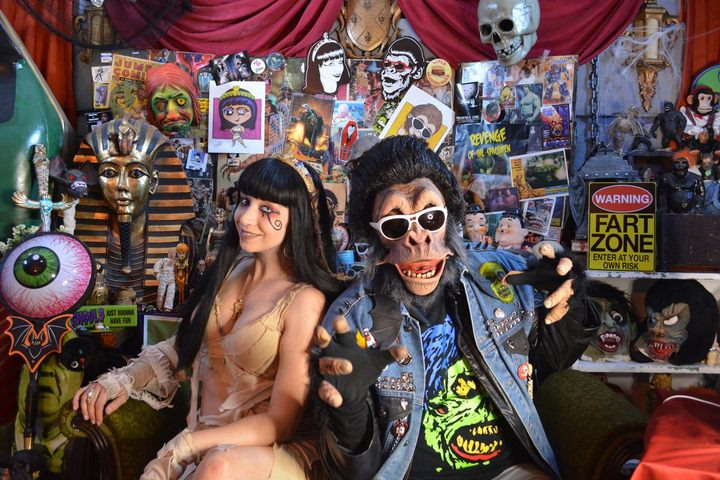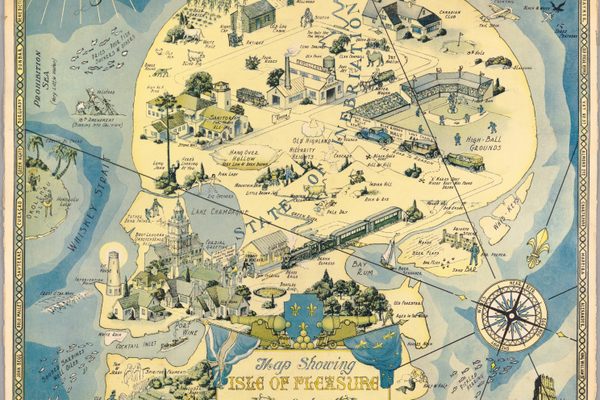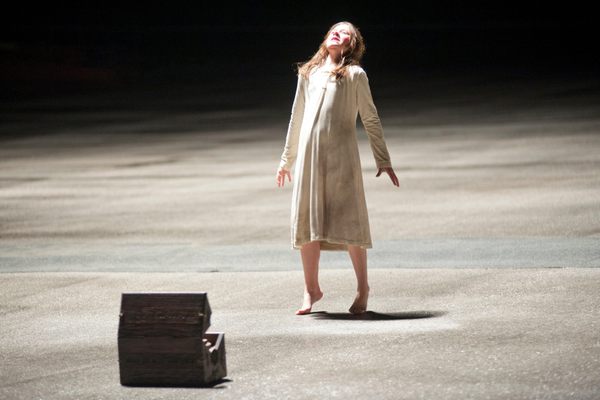
The Year in Movies, TV, and Gremlins
Exploring Patricia Arquette’s desert obsession, how Elvira became the queen of late night horror, and other behind-the-screen stories.
It’s no secret that at Atlas Obscura we love finding strange stories from behind the screen. Whether we’re investigating what happened to a lost BBC horror show—a series so terrifying it was (mostly) destroyed—or delving into how sharks can cause all sorts of problems for filmmakers, we just can’t get enough of it. As 2023 comes to a close, we’ve scoured our archives for our favorite film and TV stories from the year.
From Elvira to Svengoolie, Local Horror Hosts’ Frightfully Fun History
by Tea Krulos
You may have heard of Elvira or Svengoolie; but have you heard of Cleveland’s Janet Decay or Wisconsin’s Dr. Destruction? For decades, local horror hosts like these have donned costumes and masks to tell jokes and revel in the absurdity of classic horror films. It’s a storied American tradition that goes back to the early days of cinema and continues today: Many towns have their own costumed spook ready to introduce horror classics like 1959’s The Wasp Woman or 1974’s Shriek of the Mutilated.

Sharks Have Long Caused Trouble for Filmmakers
by Roxanne Hoorn, Editorial Fellow
Shark attacks are extremely rare. According to The Washington Post, beachgoers are far more likely to die in a riptide or from falling in a hole than from a shark attack. Nevertheless, when filmmakers such as Steven Spielberg go searching for great whites with heavy film equipment, sharks can get—understandably—wary. In rare cases, they’ll even attack cameras or rip apart dive cages. In this story, we explore the difficulties of capturing sharks for the screen. It seems they’re not quite ready for their close-up.
The Twisty Tale of the BBC Show Supposedly So Terrifying That It Was Destroyed
by Pat Cassels
In 1985, Chris Perry wanted to see something scary—specifically, he and his friend, fellow vintage TV collector Richard Down, wanted to watch an old BBC2 show called Late Night Horror. The show only aired for a brief period before it was deemed too frightening for the public and all copies of its six episodes were allegedly destroyed. It would take Perry and Down the next three decades to acquire and finally watch an episode of the BBC show almost too terrifying to preserve.
These FX Artists Make Nightmares Come Alive (Or At Least Undead)
by Karuna Eberl
How do you bring someone’s nightmares to cinematic life? To find out, we sat down with two Hollywood FX artists, who have created everything from animatronic alien babies to Val Kilmer’s severed hand.

Patricia Arquette Has a Thing for the Weird Art of California’s High Desert
by Matthew Taub
You might have caught Patricia Arquette in High Desert, an AppleTV+ comedy series where she plays P.I. Peggy Newman. The show’s funny, poignant, and, like the High Desert itself, just the right amount of weird. We sat down with the celebrated actress to get her insights on the series, as well as her recommendations for what to do and see in Peggy’s strange, sandy corner of California.
Rocky Horror Has Surprising Roots in Victorian Seances
by Victoria Linchong
The beloved Tim Curry-helmed film has deep roots that go back to the Victorian era. Join us on this “Time Warp” through history, tracing the film’s influences back to 1930s midnight spook shows and 19th-century séances.
How to Ensure the Last Gas-Lamp Theater in the World Doesn’t Blow Up
by Jenny Elliott
Hyde Park Picture House in Leeds, England, is thought to be the only gas-lamp cinema left in the world. Throughout its 109 years of existence, the theater has always been lit by gas lamps. In order to maintain the historic lighting, the building’s team needed to learn the complicated secrets of an almost-extinct trade—or risk the whole place blowing up.

How Gremlins Went From Fairy Stories to Warplanes to Hollywood Legend
by Hadley Meares, Atlas Obscura Instructor
It was 1944, and an Allied pilot was flying a B-17 bomber over Nazi territory. Suddenly, the plane began to rattle. When the pilot glanced out the cockpit window, he saw a three-foot-tall hairless, gray creature with teeth sharp as knives and glowing red eyes. While today we know gremlins for the iconic film that bears their name, tales of these monstrous beings took form during World War II. Each subsequent gremlin iteration has continued to reflect our changing fears and anxieties.
The Bizarre, True Story of Gef the Talking Mongoose
by Steven Tucker
Sometime around 1933, two teenagers paid a visit to a new friend of theirs named Gef. Gef lived in a remote, windswept farmhouse on the Isle of Man. He was very shy, and the teenagers never saw their companion—only communicated with him through the walls. At first, Gef was very nice, but soon he began misbehaving, spitting, and threatening the boys that he would “wet on [their] head!” Gef, it turns out, was no normal boy—he was a poltergeist in the form of a talking mongoose.













Follow us on Twitter to get the latest on the world's hidden wonders.
Like us on Facebook to get the latest on the world's hidden wonders.
Follow us on Twitter Like us on Facebook